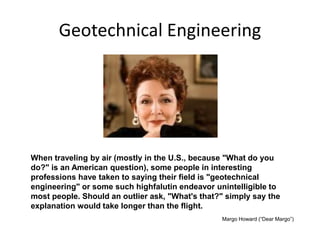The Single Strategy To Use For Geotheta
Table of ContentsTop Guidelines Of GeothetaEverything about GeothetaThe Definitive Guide to GeothetaTop Guidelines Of Geotheta6 Simple Techniques For Geotheta

They conduct website examinations, collect examples, carry out lab examinations, and analyze data to assess the suitability of the ground for building jobs - Engineer of Record. Based on their findings, geotechnical designers supply referrals for structure style, slope security, preserving structures, and reduction of geotechnical dangers. They work together with other experts, such as designers, structural engineers, and construction teams, to make sure that geotechnical factors to consider are incorporated right into the total task design and execution
By assessing the actions and properties of dirt and rock, they can determine prospective geotechnical hazards such as landslides, soil settlement, or incline instability. Their knowledge helps prevent failings or accidents that might threaten lives and residential or commercial property. Below are some comprehensive duties and responsibilities of a geotechnical designer: Website Investigation: Geotechnical designers conduct website examinations to gather information on subsurface conditions.
They analyze the information to understand the buildings and actions of the dirt and rock, including their toughness, leaks in the structure, compaction features, and groundwater problems. Geotechnical Evaluation and Design: Geotechnical designers examine the information gathered throughout site examinations to analyze the stability and suitability of the site for construction jobs. They execute geotechnical estimations and modeling to examine elements such as birthing capability, settlement, incline security, side earth stress, and groundwater circulation.
The Single Strategy To Use For Geotheta
Structure Design: Geotechnical engineers play a vital function in making foundations that can safely sustain the designated framework. They assess the soil conditions and tons requirements to establish the suitable structure type, such as superficial structures (e.g., grounds), deep foundations (e.g (https://www.producthunt.com/@geotheta1)., heaps), or specialized strategies like soil enhancement. They think about aspects such as settlement limits, bearing capability, and soil-structure interaction to develop ideal foundation styles
They examine construction plans, display website tasks, and conduct field examinations to confirm that the style referrals are followed. If unpredicted geotechnical issues arise, they analyze the scenario and give recommendations for removal or modifications to the design. Risk Evaluation and Mitigation: Geotechnical engineers examine geotechnical dangers and risks linked with the job website, such as landslides, liquefaction, or soil erosion.

Partnership and Interaction: Geotechnical designers work carefully with other specialists involved in a job, such as designers, structural engineers, and construction teams. Reliable communication and cooperation are necessary to integrate geotechnical considerations right into the total job design and building and construction procedure. Geotechnical designers offer technical experience, solution questions, and ensure that geotechnical requirements are fulfilled.
Geotheta for Beginners
Below are some types of geotechnical designers: Structure Engineer: Foundation engineers focus on making and examining foundations for structures. They assess the soil conditions, load needs, and website characteristics to establish the most ideal foundation type and style, such as shallow foundations, deep structures, or specialized techniques like pile structures.
They examine the elements affecting incline stability, such as dirt homes, groundwater problems, and incline geometry, and develop strategies to stop slope failings and alleviate risks. Earthquake Engineer: Quake designers focus on evaluating and making frameworks to withstand seismic forces. They examine the seismic risk of a website, review dirt liquefaction potential, and establish seismic style requirements to make certain the safety and security and durability of structures throughout earthquakes.
They perform area screening, gather samples, and assess the accumulated information to define the soil buildings, geologic developments, and groundwater problems at a website. Geotechnical Instrumentation Engineer: Geotechnical instrumentation engineers focus on monitoring and measuring the habits of dirt, rock, and frameworks. They mount and preserve instrumentation systems that keep track of elements such as soil settlement, groundwater levels, slope motions, and architectural displacements to evaluate efficiency and Tailings Engineer provide early warnings of prospective problems.
Getting My Geotheta To Work
They perform tests such as triaxial tests, loan consolidation tests, straight shear examinations, and permeability tests to collect information for geotechnical analysis and style. Geosynthetics Engineer: Geosynthetics designers specialize in the design and application of geosynthetic materials, such as geotextiles, geogrids, and geomembranes. They make use of these materials to enhance dirt stability, enhance inclines, supply drainage services, and control disintegration.
They have a tendency to be investigative people, which means they're intellectual, reflective, and analytical. They wonder, systematic, rational, logical, and logical. Several of them are additionally social, indicating they're kind, charitable, participating, individual, caring, valuable, understanding, skillful, and friendly. Does this seem like you? Take our complimentary career examination to discover out if geotechnical designer is just one of your leading job matches.
In the office setting, geotechnical engineers make use of specialized software program devices to execute computations, produce styles, and assess data. They prepare reports, evaluation job specifications, connect with clients and staff member, and coordinate job tasks. The office setup offers a favorable atmosphere for research, evaluation, and collaboration with other experts associated with the project.
Some Ideas on Geotheta You Need To Know
They regularly check out project sites to carry out site investigations, examine geotechnical conditions, and gather data for evaluation. These sees include traveling to different areas, often in remote or tough terrains. Geotechnical designers may carry out dirt sampling, conduct examinations, and monitor building and construction activities to make certain that the geotechnical facets of the project are being carried out properly.
Geotechnical designers additionally function in specialized geotechnical research laboratories. In these centers, they conduct experiments, do examinations on dirt and rock samples, and examine the design properties of the materials. Geotechnical laboratory engineers function extensively in these environments, managing screening tools, running tools, and videotaping information. They collaborate with other lab staff to make sure accurate and trusted screening outcomes.